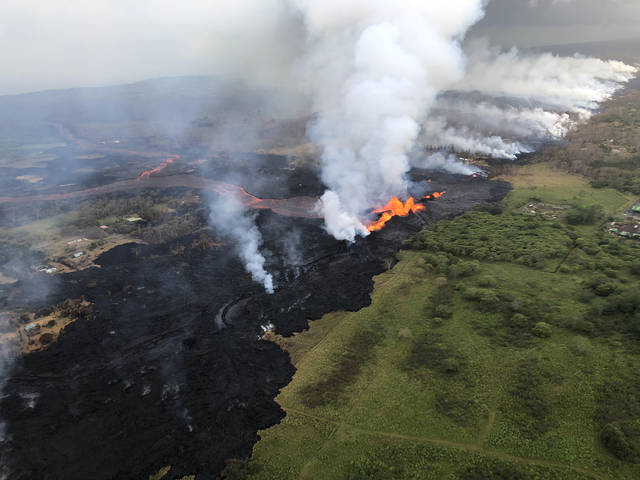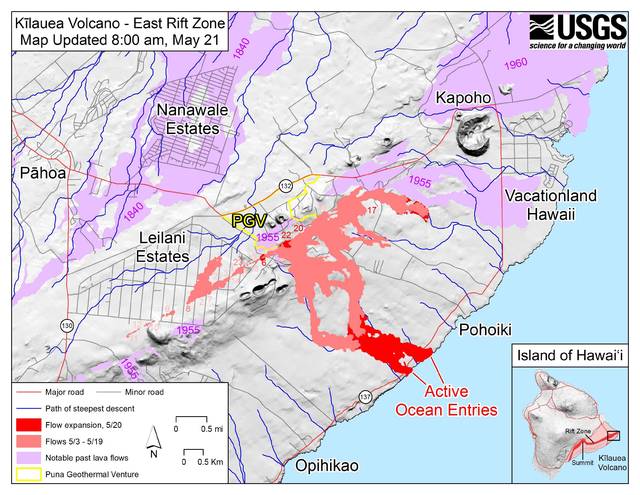HILO — As lava breached the southern boundary of Puna Geothermal Venture on Monday, the head of a task force created to mitigate potential hazards at the power plant said efforts were underway to neutralize the last “active” well on the property.
Tom Travis, the chief of Hawaii Emergency Management Agency, said during an afternoon media briefing he hoped efforts to “quench” well KS-14 would prove successful sometime Monday night.
Hawaii County Civil Defense reported Monday morning that lava from fissure 22 had spilled over onto the PGV property and had come within 200 to 300 yards of the power plant’s well pad before being stalled by a berm. Fissure 22 also delivered lava into the ocean at two spots near MacKenzie State Recreation Area on Monday, with molten rock traveling on one of the same paths as lava from fissure 20, which was no longer feeding the ocean.
The main concern, should lava overrun the well pad, is the release of hydrogen sulfide (H2S), a colorless, highly flammable and toxic gas.
“This is important, because … lava is starting to intrude on the southern edge of Puna Geothermal Venture site. It’s not easy to predict where it’s going to go or when it’s going to get there,” Travis said.
Talmadge Magno, Hawaii County Civil Defense administrator, said his agency is preparing for “a possible H2S release, as far as messaging to the community and evacuations that might have to take place.”
“We haven’t specifically mentioned hydrogen sulfide, but with this flow coming on to the PGV property, we’ll start acknowledging that this is the next precaution that folks will have to take,” Magno said.
The geothermal plant was taken offline after lava from Kilauea volcano broke out from numerous fissures along the volcano’s Lower East Rift Zone in Puna on May 3. Officials say 60,000 gallons of pentane, a highly flammable liquid used by the facility, was eventually removed from the property and stored at Shipman Business Park in Keaau.
Travis said about a half-dozen highly-skilled workers are “quenching the wells.” He described that process as filling them with enough cold water so the weight of the water is more than the pressure from the volcanic steam below can overcome, effectively cooling the well. He said once the well is neutralized, it can be capped. Travis said metal well caps were en route and should arrive at PGV for installation by today.
According to Travis, mud, as well as water, was being pumped into KS-14. He expressed optimism that the work, if successful, would hold up if the well pad was overrun by lava, but opined a worst-case scenario at the geothermal plant would carry less severe consequences than the blowout of well KS-8 while it was being drilled on June 12, 1991. The blowout caused what an independent technical investigation by the University of North Texas described as “the unabated release of steam for a period of 31 hours before PGV succeeded in closing in the well.”
In the 1991 blowout, the stench of hydrogen sulfide, which has a rotten-egg smell, prompted the evacuation of nearby residents. The noise, which was described as like a jet airplane taking off, reached 90 decibels. And a worker suffered a minor injury in the blowout.
In related developments Monday, the U.S. Environmental Protection Agency said in a statement it worked with the state Department of Health to establish 10 air-monitoring station locations and continues to work with DOH and the county to provide data about sulfur dioxide, hydrogen sulfide and particulate levels. EPA said it is evaluating data collected from DOH’s Air Now Network.
Jim Kauahikaua, a HVO geophysicist, said a “short section” of fissure 22 was “actually fountaining lava up to 140 meters at times.” That’s about 450 feet.
“The channel going into the ocean is quite broad, but it is currently feeding only one of the ocean entries,” he said. “(There are) two flows going to the coast, but only the eastern one is currently active. There’s a fairly good sized plume coming out of the ocean and there was a (lava) delta being formed. … It was about 80 yards from the old coast to the new coast.”
As of press time, lava had destroyed 46 or 47 structures, and fires were burning in vegetated areas, causing a danger from methane gas, as well as sulfur dioxide, hydrogen sulfide and “laze” — volcanic haze carrying a caustic mix of steam, sulfur dioxide and volcanic glass particles caused by lava’s interaction with ocean lava.
Civil Defense said Kalapana and Kapoho roads are open to residents only and identification is required. Highway 137 is closed to all traffic between Kamaili and Pohoiki roads. Kamaili Road is closed to all through traffic with no stopping allowed because of high sulfur dioxide levels.
All residents in and below the lower East Rift Zone are advised to be ready to evacuate with little or no notice. Magno said he’ll use any means necessary to communicate with at-risk residents.
“We understand that there is some difficulty getting the message out because of the (lack of) connectivity out there, so we still have a lot of (police) officers, National Guard (and) county staff on the ground, so we’ll utilize them to get the message out,” he said.
Hawaiian Volcano Observatory reported another explosive eruption at Halema‘uma‘u rocked Kilauea’s summit at 5:51 p.m., sending another ash plume into the air.
Email John Burnett at jburnett@hawaiitribune-herald.com.


